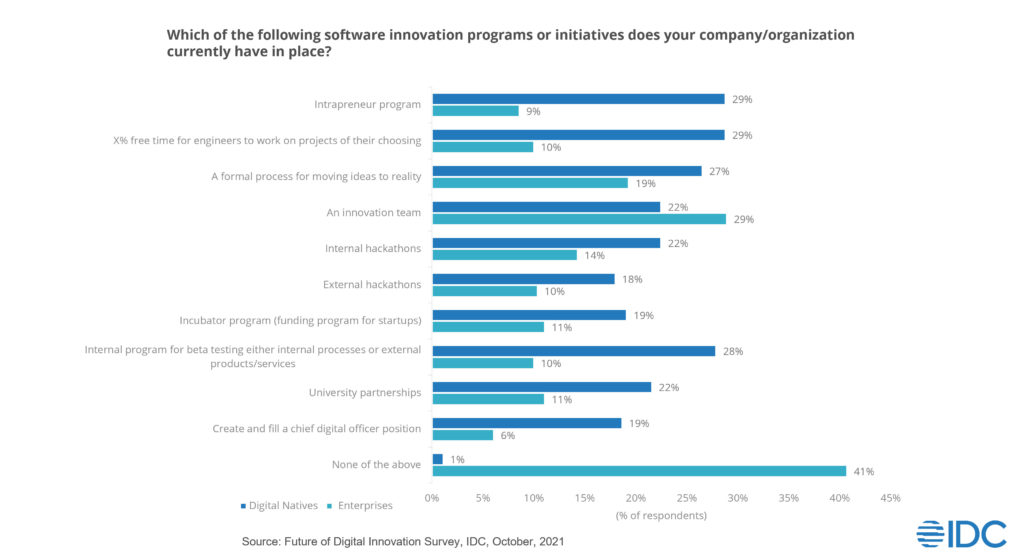“Digital” is everywhere. Where once there was digital transformation, now there’s the “digital enterprise,” “digital first,” “chief digital officers” and “digital innovation.” It’s even used as a noun, as in “an enterprise’s spend on digital.”
What’s the distinction? I won’t attempt to describe all of the “digital” terms currently relevant to enterprises, but I will, based on my discussions with enterprises and research over the past year or so, touch on topics that have emerged as important factors that define digital innovation.
Digital innovation is a subset of many of the other “digital” topics. An organization may add a new digital channel, like an e-commerce site, or modernize a back-office process, such as through digital document management. While impactful, those examples aren’t necessarily innovative. An innovative digital product or service is disruptive, differentiating, or unique. It’s also difficult to deliver, especially for the many enterprises that have traditionally bought software but have not developed software in any significant fashion.
Disruptive, differentiating, and unique are lofty terms that aren’t defined easily. As we’ve dug deeper into the topic of digital innovation, we’ve teased out some questions that help determine whether a digital deliverable is innovative:
Is it a value engine? One commonality we’ve discovered across many innovative digital products and services is that they often create more value beyond the initial intention. We think of this type of digital product or service as a software value engine.
Here’s an example: Damen, a shipbuilder, offers a service that collects and analyses data about a ship’s operations, providing insight to owners and operators that can improve maintenance and ship performance. Once Damen rolled out its service, it began receiving requests for data analytics from companies in sectors it had never served before, such as financial services and insurance. The original digital offering became a value engine on which Damen can now build new products and services that create new revenue streams.
While it may sound like chance that allowed Damen to spin off additional products, it wasn’t. An innovative digital product or service can be iterated on. And, a company capable of digital innovation is open to feedback from third parties and willing and able to put in motion an effort to deliver an additional product or service.
Does it have a significant impact on profit? A digital product or service that isn’t innovative can, in many cases, generate significant revenue. But if a unique digital product or service doesn’t have a significant positive impact on the bottom line it’s hard to consider it innovative in the context of the enterprise.
Increasingly, we’re hearing enterprises quantify revenue or expected revenue generated from digital deliverables. For instance, digital sales at Kroger are growing in triple-digit percentages, reaching more than $10 billion in 2020 (the company’s last full year report). GM has set a goal of growing software-enabled services revenue to $20 billion to $25 billion annually by 2030. In its Q3 2021 earnings report, McDonald’s reported that 20% of sales – about $13 billion – came through digital channels. While in some cases these companies are using digital products and services to play catch up to competitors, their abilities to deliver innovation will determine whether they can deliver important business outcomes over the long term.
Does a company’s innovative digital product or service have a notable impact on its sector? For instance, does delivering the digital product or service allow the company to steal customers from the competition? Does it set off a round of M&A activity? Is the sector being redefined? Here, there are many well-known examples: think of Lyft and Uber’s impact on the taxi industry, AirBnB’s effect on hospitality, and Nextflix’s impact on cable television. In each of those examples, a digital product or service sent entrenched players scrambling to follow the lead of the disruptor and redefined the types of companies competing in the sector.
While the above may help describe digital innovation, it doesn’t begin to touch on the topic of how to deliver and drive digital innovation. Herein lies the challenge because there’s no “top 10” practices that will work for every organization. That said, there is one thing that’s certain: doing nothing won’t produce innovation.
Last year, our Future of Digital Innovation survey helped us discover how digital natives approach digital innovation differently from enterprises. We found a dramatic difference in terms of the digital innovation practices employed by enterprises and digital natives. Nearly 41% of enterprises said they hadn’t implemented any of the innovation initiatives or programs, compared to 1% of their digital native counterparts.

The exact set of initiatives that will successfully spur innovation in your organization will be different from those used in other companies. But learning about what some companies are doing should help you think about the types of practices that are likely to be successful for your organization.
My colleague, Phil Carter, recently detailed a number of processes adopted by Toyota Financial Services, an organization that makes an excellent example of thinking of an innovative digital service as a value engine and adopting intentional practices. McDonald’s offers other good examples: its CIO told Villanova University professor Noah Barsky (in his Forbes article) about running hackathons and inviting startups to pitch new ideas.
My recommendation to enterprises that recognize the imperative of delivering innovative digital products and services is to be intentional. Look to leading enterprises for mechanisms that you can put in place that will enable digital innovation. And, recognize that doing nothing won’t pave the way to innovation.
Interested in learning more about driving digital innovation in your organization. Download our guide, Best Enterprise Practices: Developing Digital Offerings.




